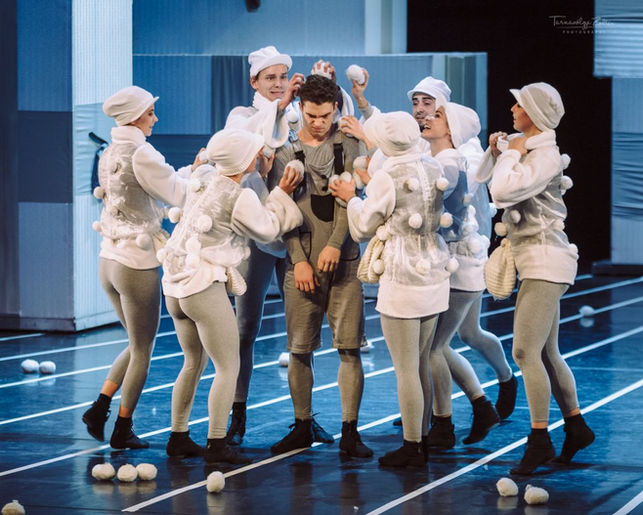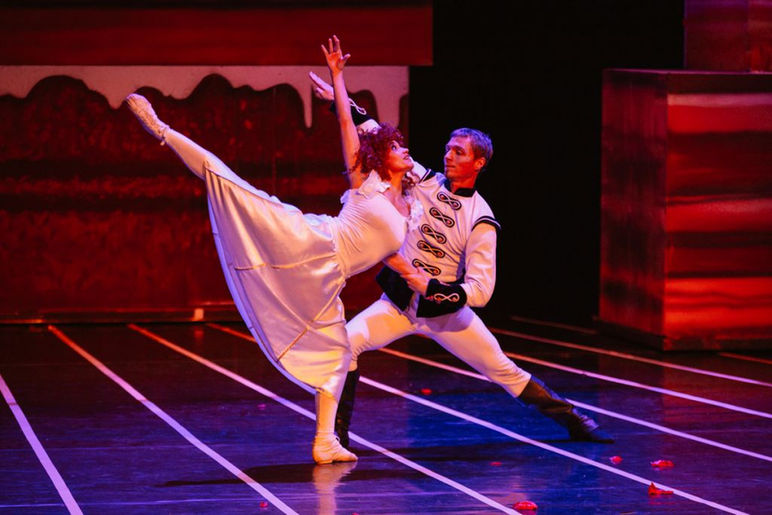Step beyond the velvet curtain and into a world where sugarplums dance, and snowflakes twirl. The Nutcracker awaits, arms wide like an invitation to a dream.
The idea for The Nutcracker ballet came from the one-time director of the Tsarist theatre who, based on E.T.A. Hoffmann’s fairy tale entitled the Nutcracker and the Mouse King, wanted to stage a fairy tale ballet that would surpass all that had gone before, both in sound and in spectacle. Tchaikovsky was asked to compose the music and after Swan Lake and Sleeping Beauty his third and final ballet was also a great success. It was the six-movement suite of the music of The Nutcracker that was first performed in March 1892, and in December of the same year the spectacularly presented theatrical work was also performed. The Nutcracker has become the most frequently played ballet piece of all time. On Christmas Eve Marie and her family are getting ready for the Christmas gathering. The children arrive one after the other and the exchanging of gifts begins. There are lots of nice toys, fairy tale figures and puppets under the tree. Drosselmeyer, the children’s fanciful godfather, presents Marie with a nutcracker puppet. Fritz, Marie’s brother is constantly making pranks. After the guests have left the house, the little girl sneaks back to the Christmas tree to be able to go to sleep with the new toy. Drosselmeyer sends her off into the magical world of dreams. In her dream the images of recent events, the puppets and toys come to life. Everything becomes giant and mice emerge from the gift boxes. The series of adventures begins. Later, Prince Nutcracker happily greets Marie, who in the meantime has grown into a beautiful young lady and sees many interesting things arriving at Cake Palace. The sometimes frightening and other times wonderful dreams of the little girl are presented in the story.
Choreographer
Tamas Juronics
Artistic Director, dancer, choreographer and director (born February 5, 1969, Tata). After graduating from the Folk Dance Faculty of the Hungarian Dance Academy in 1987, he accepted the invitation of Zoltán Imre to join the Szeged Ballet where he became soloist from 1989. In 1990 he created his independent studio within the company for his choreographic experimentations. He started introducing his own choreographies from 1991 and remained the company’s leading soloist. In 1993, after the departure of Zoltán Imre, he became the Artistic Director of the renewed Szeged Contemporary Dance Company. In his creations, philosophy and emotions are mixed with intellectual motives. Among the Hungarian choreographers, he was the first to use the elements of contemporary dance which are characterized by clear technical skills; this partly lies in the modern methods such as Limon or Cunningham, partly in his own improvisational dance moves. As a guest teacher, he attended masterclasses in Amsterdam and Zurich (1994) and in Italy (1999, 2005). By now Juronics has grown to be an internationally acclaimed creator with 65 choreographies under his name. The careful combination of his storylines, the clear, unified form of dancing and the dramatic structure make his works a cathartic experience. Spectacular staging, lighting, effects, and music are also well-integrated parts of his works. Juronics successfully introduced himself as a director in the world of prose theatre as well and has also become a popular choreographer, director of several musicals and operas in many theatres.

Company
Szeged Contemporary Dance Company
The classical music repertoire of the company consists of theatrical dances based on the works of composers such as Tchaikovsky, Stravinsky, Bartók, Orff, Eötvös, and the company’s varied repertoire also contains choreographies composed to musical montages. Besides the leading choreographer Tamás Jurionics, several renowned European choreographers created modern art dances for the company. In 1993 they picked up the name Szeged Contemporary Dance Company, with appointing Tamás Juronics as artistic director and András Pataki as executive director. Since 2000 the Szeged Contemporary Dance Company is working as an autonomous company in a form of prominently public benefit foundation. Besides their national successes, they have won the recognition of the audience and professionals while performing abroad on diverse occasions. Tamás Juronics had an outstanding role in forming their especially unique artistic identity. He considers the continuous training of the dancers and the enrichment of the repertoire to be his most important task. The ability of reception and individualization of the contemporary and modern technics, the high quality of the artistic expression based on the technical safety makes the repertoire to be incredibly varied, yet unique. Among the peculiarities of the artistic characters, we should emphasize the diverse effect-elements of performing styles that compose originality. Respecting the ‘laws of stage’ is a defining attribute in their shows, so is the using of theatrical means - in the literal sense of the word - that are enhancing the effect and intensity of vision. The Szeged Contemporary Dance Company is a constant guest of local and oversea dance stages. The company itself and its dancers have also been rewarded by international and national, vocational and as well audience prices. During their tours, the ensemble played in 22 different countries 134 times in the last 22 years.

Music: Music: Pyotr Ilyich Tchaikovsky
Choreographer: Tamás Juronics
Director: András Echéry-Pataki
Set-costumes: Zsuzsa Molnár
Lightning: Ferenc Stadler















